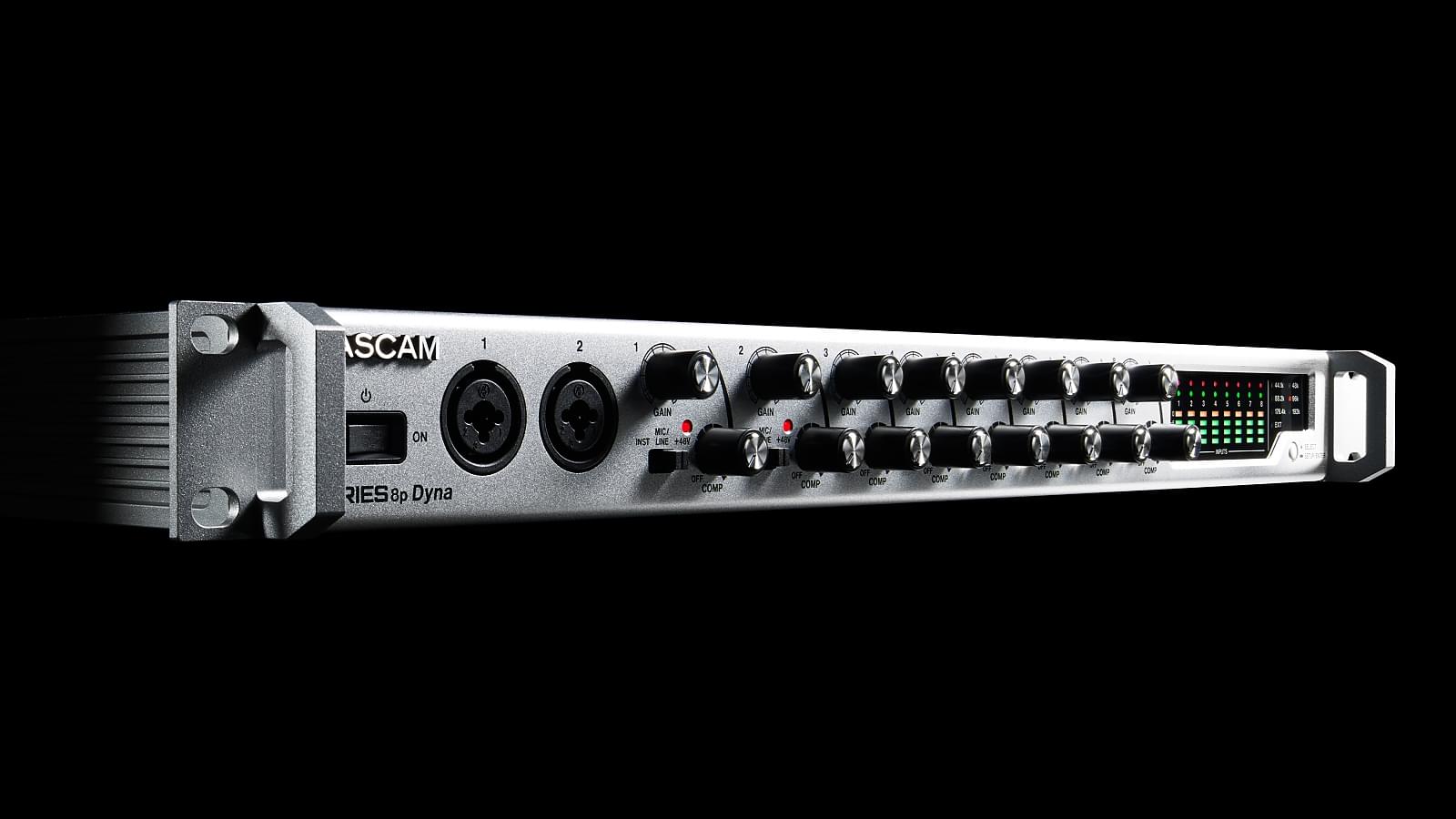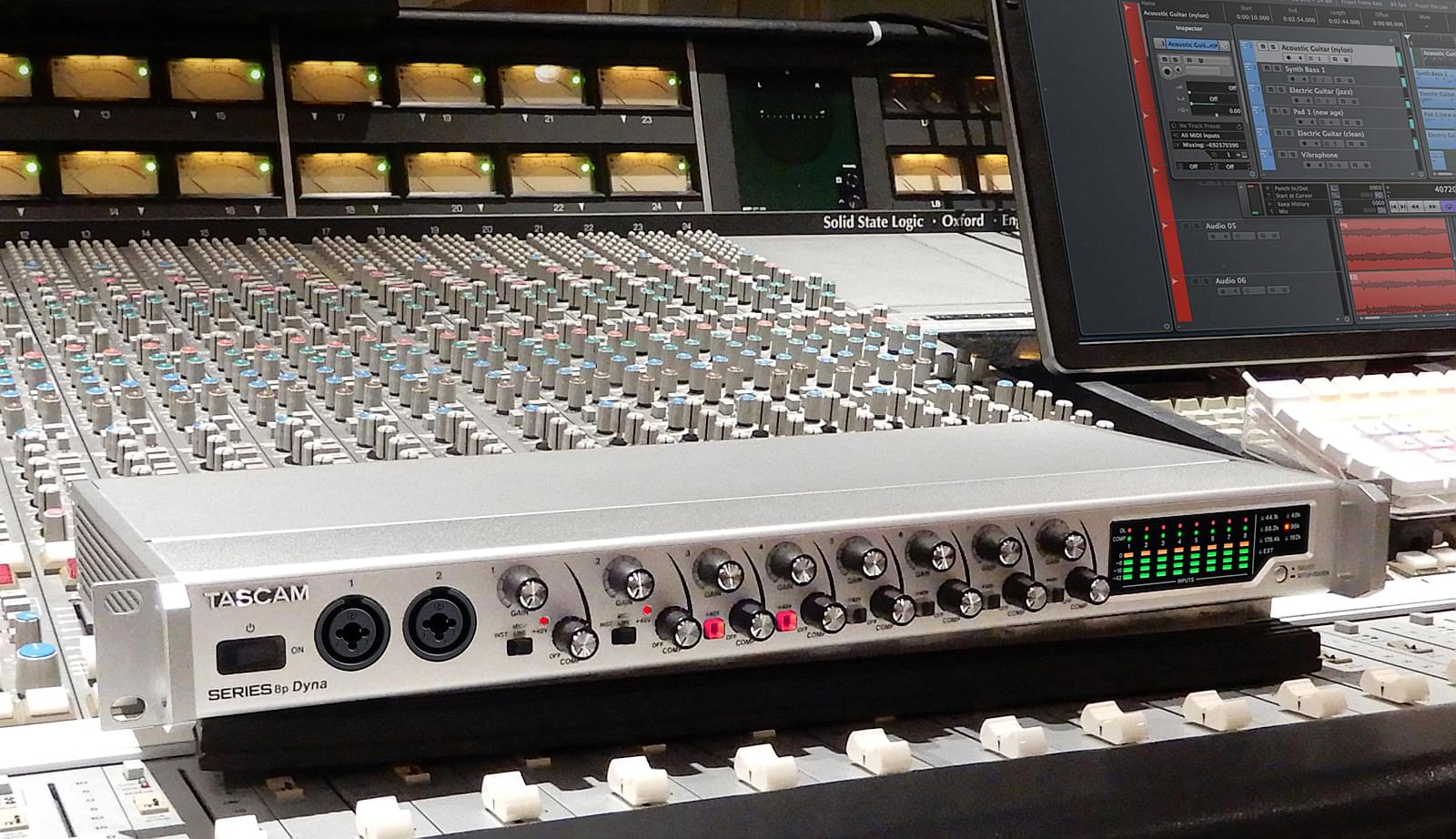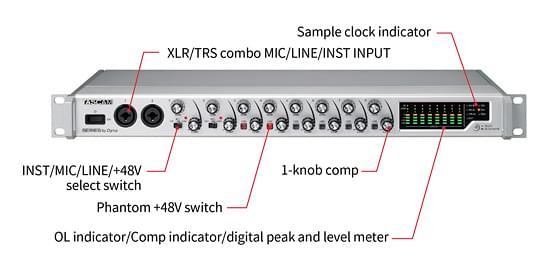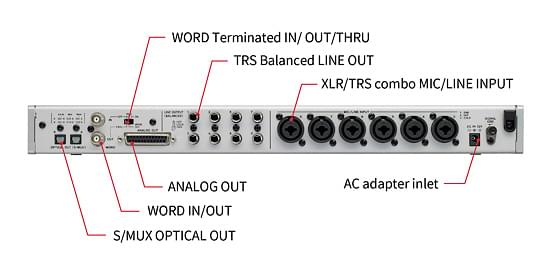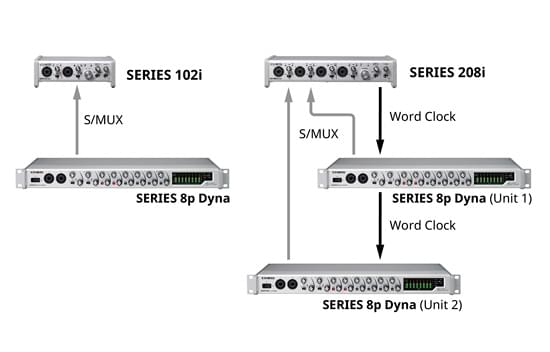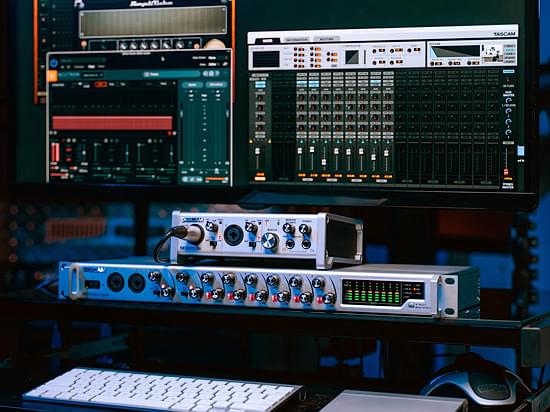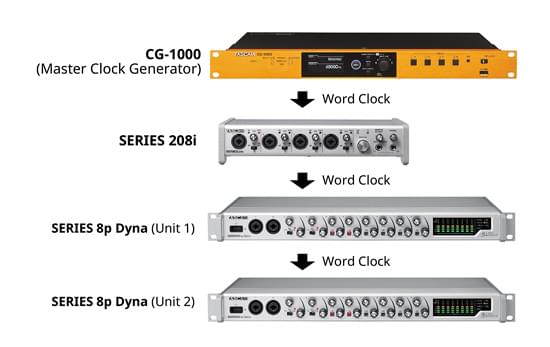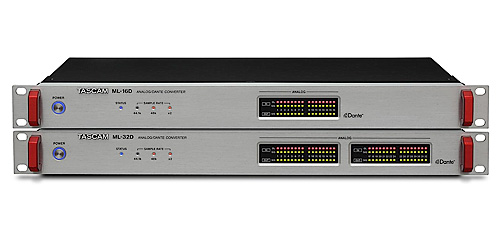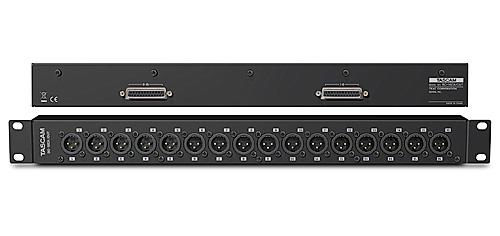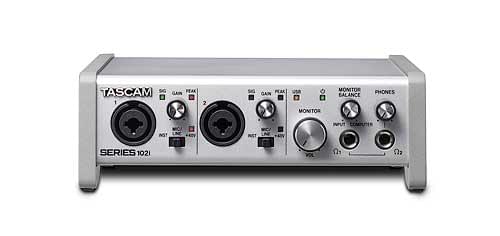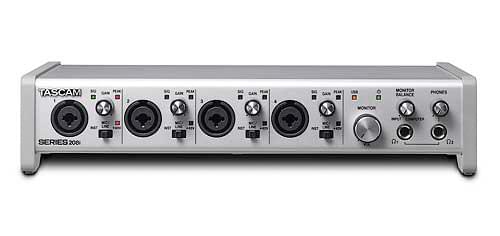SERIES 8p Dyna
8-Channel A/D Converter and Mic Preamp With Analogue Compressor
With superb audio specifications and connectivity and featuring an outstanding microphone preamp, the Tascam SERIES 8p Dyna is a great choice for both studio and stage. Housed in a rugged 1U rack-mount casing, its dual S/MUX optical ports make it a perfect expansion unit for a Tascam SERIES 102i or 208i or other S/MUX-equipped audio interfaces including ADAT, or use it as a stand-alone front end. In addition to eight separate TRS outputs, the SERIES 8p Dyna also has a multi-channel balanced analogue output that connects to an BO-16DX/OUT XLR breakout box, for example. And wordclock I/O ensures perfect synchronisation when using multiple units in parallel or operating with other professional equipment.
Each microphone channel features individually switched +48V phantom power for use with condenser mics, and an easy-to-use, single-control analogue compressor with true bypass. A comprehensive display informs about signal levels, compression, overload and the current sampling rate.
What can the Tascam SERIES 8p Dyna do for you?
A Superior Front End for Studio and Stage
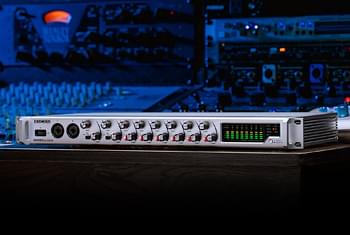
Tascam has long been known for transparent, natural, ultra-low-noise preamps, and the eight excellent Tascam HDIA (High Definition Instrumentation Architecture) preamplifier circuits in the SERIES 8p Dyna are its best preamps yet: The noise level (EIN) is at –127 dBu, the THD is 0.0007%, the dynamic range is 116 dB, and the crosstalk attenuation is 119 dB. An easy-to-use, single-control analogue compressor with true bypass on each channel handles hot input signals and creates smooth audio input.
Versatile Features
With two instrument/microphone combo inputs on the front panel, you can quickly plug in mics, guitars, bass and more. Six balanced mic/line inputs grace the rear. Every microphone input has individually switched +48V phantom power for using different types of microphones such as dynamic, condenser, ribbon and vintage for proper operation and safety. It adds up to a multi-purpose front end for recording and live sound.
Expand Your Interface or Other Device
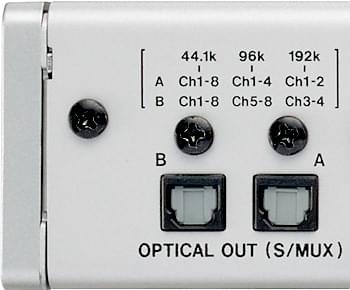
Dual S/MUX optical outputs on the rear of the SERIES 8p Dyna enable you to use the unit as a front-end expander for S/MUX-equipped audio interfaces, such as Tascam’s SERIES 102i and 208i, and US-20x20. ADAT is also supported for compatibility with other devices. With two S/MUX outputs, you can send all eight SERIES 8p Dyna channels at up to 96 kHz (four channels at 176.4 kHz or 192 kHz) to expand your system’s capabilities with ease.
Send to Anything

The SERIES 8p Dyna’s eight line-level analogue channel outputs are provided on both 6.3-mm balanced TRS connectors and a balanced 25-pin D-Sub connector. Route signals to interfaces, recording mixers, front-of-house consoles, and pretty much anything else. Connect its D-Sub outputs to a Tascam ML-16D or ML-32D Analogue-to-Dante converter, and it becomes a pristine front end for an audio-over-IP network.
The Features Professionals Need
From its high-end preamps to its versatile outputs, the SERIES 8p Dyna is a thoroughly professional product, right down to its rugged metal 1U rack-mount enclosure. Word clock input and output connectors with an In/Out/Thru switch enable proper synchronisation of digital signals. By using, for example, the Tascam CG-1000 Master Clock Generator as the clock source for your SERIES interface and mic preamp(s), you can create a highly accurate digital audio recording system that meets even the highest demands.
Front-panel overload indicators for analogue input signals, compression indicators, and easy-to-read peak and level meter bars let you monitor the unit’s performance. Yet the SERIES 8p Dyna is simple to operate so you can stay focused on the task at hand.
Features at a glance
- Eight-channel microphone preamp with eight analogue outputs and multi-channel optical outputs
- Can be used as a standalone analogue mic preamp to expand any mixer or recording device
- Ideal to add studio-ready audio inputs to a Tascam SERIES 102i/208i or US-20x20 via a single cable
- Two S/MUX optical ports can output all eight channels up to a sampling rate of 96 kHz
- 8 outputs at 44.1/48 kHz
- 8 outputs at 88.2/96 kHz
- 4 outputs at 176.4/192 kHz
- Tascam HDIA mic preamps use instrumentation amplifiers and have outstanding specifications, enabling them to provide clear, natural sound with super-low noise
- Eight balanced XLR/TRS combo input jacks
- Channels 1–2 on the front can be used for guitars, basses and other instruments with high-impedance output
- 48V phantom power can be provided to each input channel independently
- Each input channel has its own single-knob analogue compressor with true bypass
- 25-pin D-sub and eight separate TRS analogue balanced outputs support a variety of connections with other analogue equipment
- Indicators for analogue overload, compressor and digital signals as well as level meters on the front panel
- Wordclock input and output (with THRU switch) for flexible audio clock synchronisation with other equipment
- AC adapter included (Tascam PS-P1230, with four exchangeable plug inserts)
Options
- BO-16DX/OUT can be used to provide 16 XLR balanced outputs (for up to two SERIES 8p Dyna units)
Specifications
| General | |
|---|---|
| Sampling frequencies | 44.1 kHz, 48 kHz, 88.2 kHz, 96 kHz, 176.4 kHz, 192 kHz |
| Quantization bit depth | 24-bit |
| Audio input/output channels | 8 channels |
| Analogue audio inputs | |
|---|---|
| Mic inputs (1–2 set to MIC/LINE, 3–8) | Combo connector, XLR-3-31 (1: GND, 2: HOT, 3: COLD) |
| Input impedance | 2.4 kΩ |
| Nominal input level | −58 dBu (0.001 Vrms, gain knob max.) −6 dBu (0.388 Vrms, gain knob min.) |
| Maximum input level | +10 dBu (2.45 Vrms) |
| Maximum gain | 52 dB |
| Instrument inputs (1–2 set to INST) | 6.3-mm standard TS jack (Tip: HOT, Sleeve: GND) |
| Input impedance | 1 MΩ |
| Nominal input level | −58 dBV (0.0012 Vrms, gain knob max.) −6 dBV (0.501 Vrms, gain knob min.) |
| Maximum input level | +10 dBV (3.162 Vrms) |
| Maximum gain | 52 dB |
| Line inputs (1–2 set to MIC/LINE, 3–8) | Combo connector, 6.3-mm TRS jack (Tip: HOT, Ring: COLD, Sleeve: GND) |
| Input impedance | 10 kΩ |
| Nominal input level | −48 dBu (0.003 Vrms, gain knob max.) +4 dBu (1.228 Vrms, gain knob at min.) |
| Maximum input level | +24 dBu (12.282 Vrms) |
| Maximum gain | 52 dB |
| Compressor | 1-knob analogue compressor |
| Bypass | True hardware bypass |
| Compression ratio | 2:1 |
| Threshold range | 40 dB |
| Analogue audio outputs | |
|---|---|
| Line outputs (balanced, D-sub) | 25-pin DB25 connector |
| Output impedance | ≤100 Ω |
| Nominal output level | +4 dBu (1.228 Vrms) |
| Maximum output level | +20 dBu (7.75 Vrms) |
| Line outputs (balanced, TRS) | 6.3-mm TRS jack (Tip: HOT, Ring: COLD, Sleeve: GND) |
| Output impedance | 230 Ω |
| Nominal output level | +4 dBu (1.228 Vrms) |
| Maximum output level | +20 dBu (7.75 Vrms) |
| Digital audio outputs | |
|---|---|
| OPTICAL OUT (S/MUX) | 2 × optical (JEITA RC-5720C) |
| Signal format | Multi-channel optical format (supports S/MUX2 at 88.2 kHz and 96 kHz and S/MUX4 at 176.4 kHz and 192 kHz) |
| Output channels S/MUX (44.1/48 kHz) | A: channels 1–8 B: channels 1–8 |
| Output channels S/MUX2 (88.2/96 kHz) | A: channels 1–4 B: channels 5–8 |
| Output channels S/MUX4 (176.4/192 kHz) | A: channels 1–2 B: channels 3–4 |
| Control inputs and outputs | |
|---|---|
| Wordclock input | BNC |
| Input voltage | 2–5 Vpp |
| Input impedance | 75 Ω ±10 % |
| Termination | Switchable on/off |
| Permissible frequency deviation during external synchronization | ±100 ppm |
| Wordclock output/throughput | BNC (with OUT/THRU switch) |
| Input voltage | 2 Vpp (at 75 Ω load) |
| Output impedance | 75 Ω ±10 % |
| Sampling frequencies | 44.1 kHz, 48 kHz, 88.2 kHz, 96 kHz, 176.4 kHz, 192 kHz |
| Audio performance | |
|---|---|
| Equivalent input noise | ≤–127 dBu |
| Frequency response | |
| Mic/line input to line output | 20 Hz – 40 kHz, ±0.5 dB (JEITA) 40–80 kHz, ±5 dB (JEITA) |
| Mic/line input to digital output | 44.1/48 kHz: 20 Hz – 20 kHz, ±0.5 dB (JEITA) 88.2/96 kHz: 20 Hz – 40 kHz, ±0.5 dB (JEITA) 176.4/192 kHz: 20 Hz – 80 kHz, ±5 dB (JEITA) |
| S/N ratio | |
| Mic/line/inst input to line output | ≥116 dB (GAIN knob at minimum, JEITA) |
| Mic/line/inst input to digital output | ≥113 dB (44.1/48 kHz, 88.1/96 kHz) ≥111 dB (176.4/192 kHz) |
| Distortion | |
| Mic/line input to line output | ≤0.0007% (1 kHz sine wave, maximum input level, GAIN knob at minimum) |
| Mic/line/inst input to digital output | ≤0.001% (1 kHz sine wave, maximum input level, GAIN knob at minimum) |
| Crosstalk attenuation | |
| Mic/line input to line output | ≥119 dB (1 kHz sine wave, GAIN knob at minimum) |
| Mic/line input to digital output | ≥114 dB (1 kHz sine wave, GAIN knob at minimum) |
| Power supply and other specifications | |
|---|---|
| Power requirements | DC 12 V via dedicated AC adapter (PS-P1230) |
| Dimensions (W × H × D) | 482 mm × 45 mm × 229 mm |
| Weight | 2.6 kg |
| Permissible operating temperature range | 0–40 °C |
| Included accessories | AC adapter (Tascam PS-P1230 with four exchangeable plug inserts), rackmount screw kit, owner’s manual |
Design and specifications subject to change without notice.
Page last modified: 2024-07-26 12:35:23 UTC

